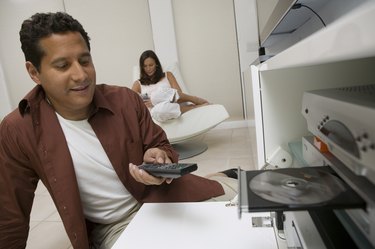
Hooking up a DVD player to your Sanyo TV is ultimately an easy process, but the vast array of input types can be confusing. It helps to have a guide through the process to help you make sense of that sea of multicolored jacks.
Making the Connection
Video of the Day
Step 1
Determine your video connection type. Your Sanyo TV has input jacks on the rear panel to accept audio and video from outside sources. Depending on what year your TV was made, your preference and available cables, these are your choices: Composite: These red/white/yellow RCA cables are a cinch to install but give the lowest-quality signal. The yellow transfers the video while the red and white cables transfer the audio. (This option will not give you surround sound.) S-Video: Slightly better than composite in video quality. You'll need a separate cable to transfer audio.
Component video: This method divides the video signal into three parts (hence the need for three cables), giving a better picture than S-video. The picture is usually indistinguishable from HDMI. You'll need a separate cable to transfer audio.
HDMI: An all-in-one solution that will transfer the highest-quality video and audio at once. Most Sanyo TVs and DVD players made since 2007 have this option. If your devices support it, HDMI is the best option.
Video of the Day
Step 2
Determine your audio connection type. You have a few choices when it comes to audio. The choice you make will depend on how you listen, your desired audio quality and the cables available. There are four options: Analog composite: These red and white RCA cables are the most common method but produce the lowest-quality sound. This method will not transfer true surround sound. Use this method if you are listening through TV speakers. Digital coaxial: If you're using a surround sound receiver or your TV features digital audio inputs, you'll want to use this method. A common RCA cable can be used. Digital optical: If you're running the cable over long distances, you can opt for this more expensive cable. In most cases you will not hear a difference between optical and coaxial. HDMI: The easiest and best option, if your TV and DVD player support it.
Step 3
Hook it up! If you're connecting directly to your Sanyo TV, choose your audio/video method and obtain the proper cables. The connection method you choose will require a specific cable—it's easy to see which cable goes where because they are shaped differently and will fit only one way. They will also have appropriate labels such as "coaxial output" or "component input." Remember to match the colors if you're using composite or component connections (red to red, green to green, etc.). Sometimes there are multiple inputs of each type depending on the TV model. In this case it doesn't matter which one you use. Power up your DVD player, insert a DVD and tune your TV to the proper input channel by pressing the "input" or "input select" on your remote until you get a picture. If you're connecting to a surround-sound receiver, connect the proper cables to the DVD inputs located on the back of the receiver in the same way you would connect them directly to your TV. Play a DVD and change the input selector on the receiver to DVD.